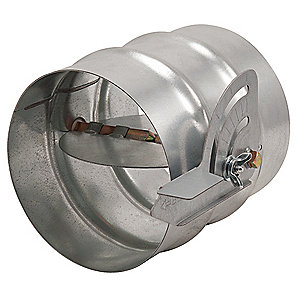Code and utility program changes have caused air balancing to be enforced across the country in most new residential HVAC installations. In some of the areas in the United States, air balancing requirements are strictly followed while in others are stretched to meet minimum compliance.
Irrespective of specifications, it is difficult to get a system to be air balanced. For proper air flow delivery to be ascertained, a professional HVAC technician has to examine every portion of the installation separately. Thanks to the availability of test instruments, air flow is no longer a subject to guesswork. There are many obstacles that stand in the way to achieving air balance in residential HVAC systems. Below are some of them:
 Absence of Balancing Dampers
Absence of Balancing Dampers
This is the number one obstacle to air balancing in forced air systems. When dampers are missing from branch ducts, technicians have a rough time adjusting air flow to individual registers. Most older duct systems have balancing dampers as part of their standard installation. The problem why some modern installations lack dampers is because a majority of the installations done today are low-cost driven. In a bid to cut installation costs, technicians remove dampers because they are viewed as obsolete.
Going forward, installers should place dampers in the duct closer to the register for accessibility and air balancing. You cannot afford to treat this as an afterthought.
Duct Leakage
For a smooth airflow, air must be able to move successfully from the air handling equipment to the register. Duct leakage is often the culprit when air flow to the register becomes significantly reduced or completely unavailable. Duct systems that have not been sealed are a problem to technicians because they cannot contain the air. Duct system leaks makes air to bypass its intended delivery and instead take the path of least resistance. To prevent this, duct systems should be sealed with the right materials.
Blower Problems
When they leave the factory floor, blowers are usually set at default fan speed positions. The default state may not match your airflow needs hence the need for customization. Unfortunately, some balancing residential systems are set up by companies outside the HVAC industry who may not have the requisite training to set up blowers to match the required amount of air flow.
In some air handling systems, the fan may be too weak to sufficiently move the required amount of airflow. Most residential fans are rated to operate at 0.50 inches of water column at maximum. This means static pressure in excess of this rating makes it difficult for the fan to move the necessary airflow.
Even when the registers are below the 0.50 inches of water column rating, it has been found that some fans are still unable to move the required air flow. For this reason, you should engage an experienced HVAC professional who understands the best fan systems out there. Some weaker fans struggle handling coils and filters which means if you add a duct system to the combination, the result is an imbalanced system. The remedy to the blower problem is to ensure the installing contractor chooses a fan for your residential HVAC system that can move the right amount of air flow.
Restrictive Coils and Filters
Air balancers often encounter problems with newer coils. Almost all modern coils have thicker slabs and more fins per inch than their traditional counterparts. As a result, they become so restrictive to airflow that the total internal static pressure of the residential system exceeds the listed rating of the equipment by about 100%. This in turn makes the air flow of your equipment to be half or even less of what is required because of the excessive coil resistance.
Ensure your installing contractor looks at the coil pressure drop data when choosing coils. Using the desired fan air flow and wet/dry condition data of a coil, they can easily determine whether the pressure drop is within the acceptable range even before the installation begins.
Filters that are incorrectly sized and do not have adequate surface area can also play a role in air balancing problems. A majority of filters are either too small or use extremely restrictive media for the application. It is always safe to keep the velocity of the filter face below that recommended by the manufacturer.
For you to have a successful air balanced equipment, your technician will have to adjust the methods he uses to install your residential HVAC system. The above pre-balancing checklist is important as it accounts for a high percentage of the balancing problems encountered.

